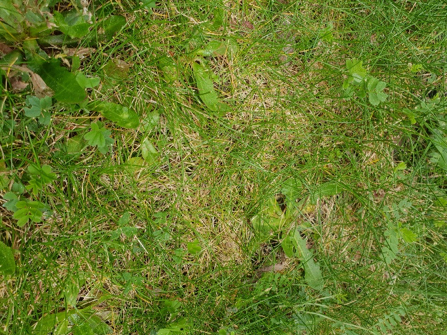
What exactly is thatch?
Thatch is a layer of organic matter which has woven together and is found between soil and grass. It can be up to 4 cm thick and causes various issues. The layer appears when organic debris produced by the grass accumulates too quickly to be broken down naturally by the soil’s organic activity. This build-up can be explained by the presence of lignin in the lawn’s various components, a biomolecule resistant to decomposition that is one of the main components of wood and rigidifies the various sections of a plant. In grass, the stem nodes, the collar (base of the grass blade) and the rhizomes all contain large quantities of lignin, which is why they decompose so slowly through biological activity and therefore form the majority of the thatch.
Why does thatch grow?
Thatch is a natural phenomenon that can be accelerated by several factors:
- Some species of grass produce more lignin and therefore more thatch.
- Acidic soil decreases the number of microorganisms capable of decomposing organic waste.
- Some pesticides can affect the population of worms that curb the production of thatch by helping grass to decompose.
- Frequent use of fertiliser will increase thatch production, as it acidifies the soil and stimulates the growth of roots, stems and rhizomes, which cause thatch.
- Intensive watering can decrease the speed at which thatch decomposes by limiting microorganism activity.
- Too much grass residue can encourage the formation of thatch.
What problems does thatch cause?
Thatch in itself is not problematic. A thin coat can protect the grass by partially insulating it, increasing its flexibility and resistance to threading whilst decreasing soil compacting. Unfortunately, in most cases, the layer of thatch becomes too thick and the disadvantages end up outweighing the benefits:
- Thatch acts like a sponge and holds water, preventing effective soil irrigation.
- Watering in dry weather is more difficult, as the grass is more likely to dry out.
- Too much thatch can make the grass more sensitive to differences in temperature.
- The thatch is an area where diseases, mushrooms and pests can develop quickly.
- Pesticides struggle to eliminate these pests, as they cannot penetrate the thatch.
- The mechanical operations required to remove thatch always risk damaging the lawn.
- Fertilisers also struggle to penetrate this organic barrier.
- The grass acidifies and moss appears faster.
Fighting moss with Belrobotics’ robotic lawn mowers!
Robotic lawn mowers are very good at decreasing the presence of thatch thanks to mulching. Frequent mowing of your lawn using this method gives your grass the nutritive elements needed for its optimal growth, unlike traditional grass cuttings. Traditional lawn mowing often involves applying fertilizer that causes excess thatch and curbs the soil’s biological activity.
Another factor in this is that the mulching method used by robotic lawn mowers produces high-quality, very fine mulch, which the microorganisms in the soil can easily break down. Conversely, traditional lawn mower cuttings congest the soil and take a long time to decompose, resulting in an increased production of thatch.
Reducing thatch growth is just one of the many advantages of our robotic lawn mowers. If you’re interested, don’t hesitate to contact our teams or ask for a quote.




